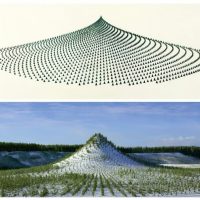Tree Mountain: A Living Tome Capsule – 11 000 Trees – 11 000 People – 400 Years, Ylöjarvi, Finland, 1992-1996
Agnes Denes has created an oeuvre whose hallmark is the synthesis of the knowledge that is accumulated in the diverse fields of science and the free and critical spirit that distinguishes art. One of the first initiators of conceptual art, she studied natural and social sciences, philosophy, linguistics, psychology, the history of art, poetry and music, and she distilled this knowledge in unique works of art. Agnes Denes was among the first contemporary artists to examine the relationship of art and science, and her activity as a theoretician, academic and educator compares in importance with her art. It has been, ever since the 1960s, her artistic conviction that science, the treasury of centuries of universal human knowledge and experience, is, from the end of the 20th century on, mutually dependent upon art, the creation of visionary individuals, and that it is only through their cooperation and sharing of ideas that those new, globally relevant suggestions for change may emerge which can avert the ecological catastrophe that threatens mankind and can guarantee the conditions for global survival.
Agnes Denes’s works deal with ecological, cultural and social subjects, often on a monumental scale. Perhaps her best-known work is Wheatfield – A Confrontation: in 1982, she sowed a two-acre area with wheat, on a landfill in downtown Manhattan, a few blocks from Wall Street and the World Trade Center, and tended to it for months, before harvesting hundreds of kilograms of grain. With this, she emphasized global human values, and called the attention to mistaken social and economic priorities. She finished Tree Mountain – A Living Time Capsule in 1996: involving massive landscaping, this reclamation project allowed 11.000 thousand people to plant as many pine trees in a former gravel pit in Finland, granting the former inheritable custodianship of the latter, and thus ensuring that the work serve, for at least four centuries, as a valuable heritage for future generations.
Working in diverse forms and employing the most varied media, Agnes Denes is spirited and inventive in her use and reinterpretation of the theoretical findings of various natural and social sciences, philosophy, linguistics, psychology, history and sociology, and displays an exceptional aesthetic sensibility when transforming these into unique works of art. Her large-scale “public art” projects that she realized in urban and natural environments are lasting monuments to the necessity of environmentally conscious thinking and responsibility. Ethereal drawings and graphics that rely on mathematical rules and the relentless rigour of logic serve as warnings and reminders of social, economic, demographic and cultural crises that result from global environmental changes. The photo documentation of her grand visions, public space projects and installations are matched in their intellectual and artistic intensity by those project plans, sketches and models that allow a view into ide as she has not yet realized.
